Melt-in-your-mouth tender and full of flavor, this Pork Stew is very similar to the classic beef stew with a few twists. It’s easy to make and cooks low and slow in the oven for perfect results. Rosemary adds a savory note with depth of flavor from the white wine. It’s chock full of potatoes and carrots with a velvety smooth stew gravy. You’ll find all my tips below for what gluten-free flour to use as well as how to make this without wine.
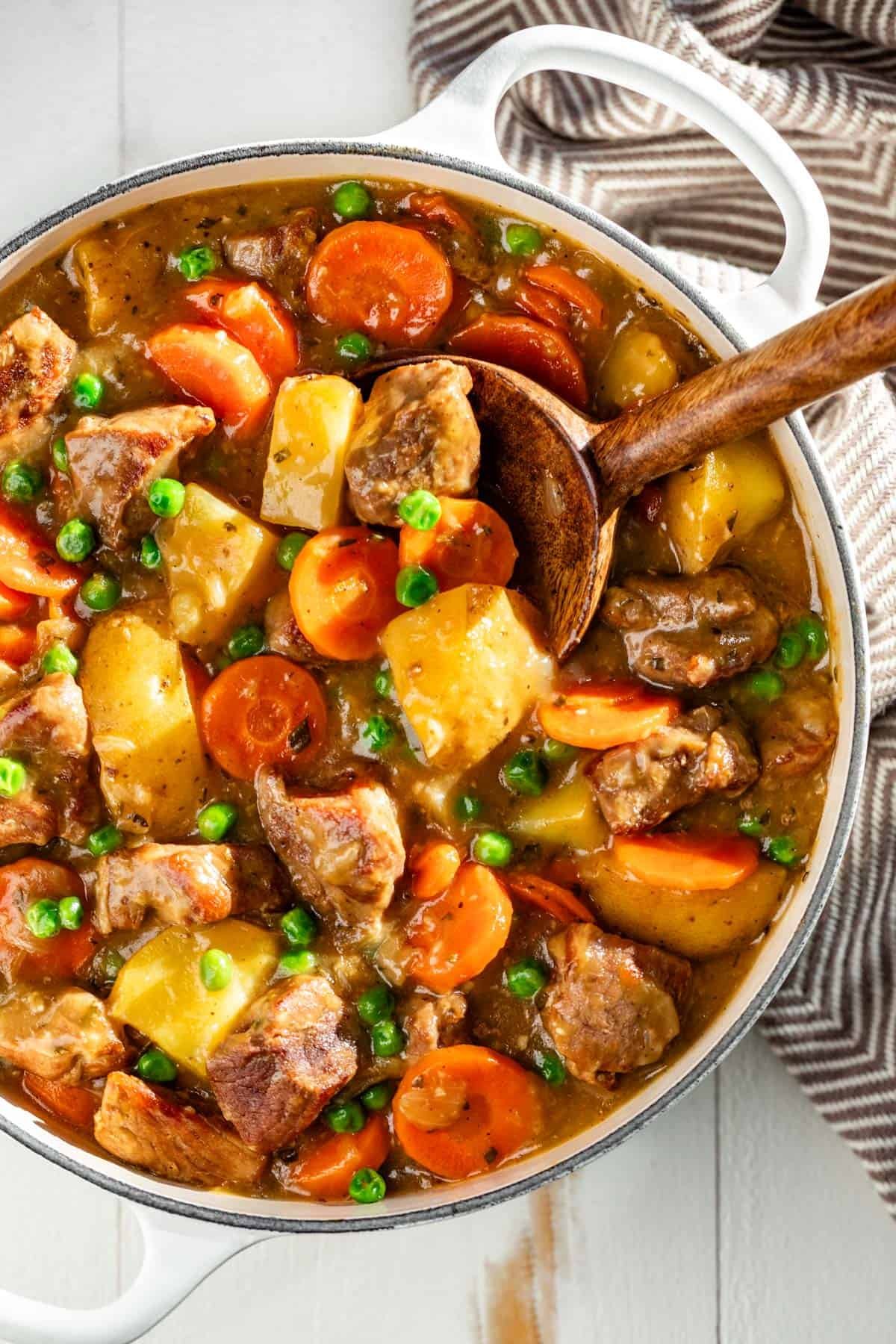
My Father-in-law loves stew so much, I developed my Beef Stew recipe for him a few years back. But these last few years have seen quite an increase in beef prices, so I’ve made this budget-friendly pork version for him instead.
Watch How To Make Pork Stew
It’s the perfect cozy meal that everyone will love, and there’s nothing like a large pot of stew simmering away in the oven to make your house smell amazing!
You’ll find my key tips below, from using pork shoulder meat for melt-in-your-mouth tender results to which herbs and wine make for the best flavor.
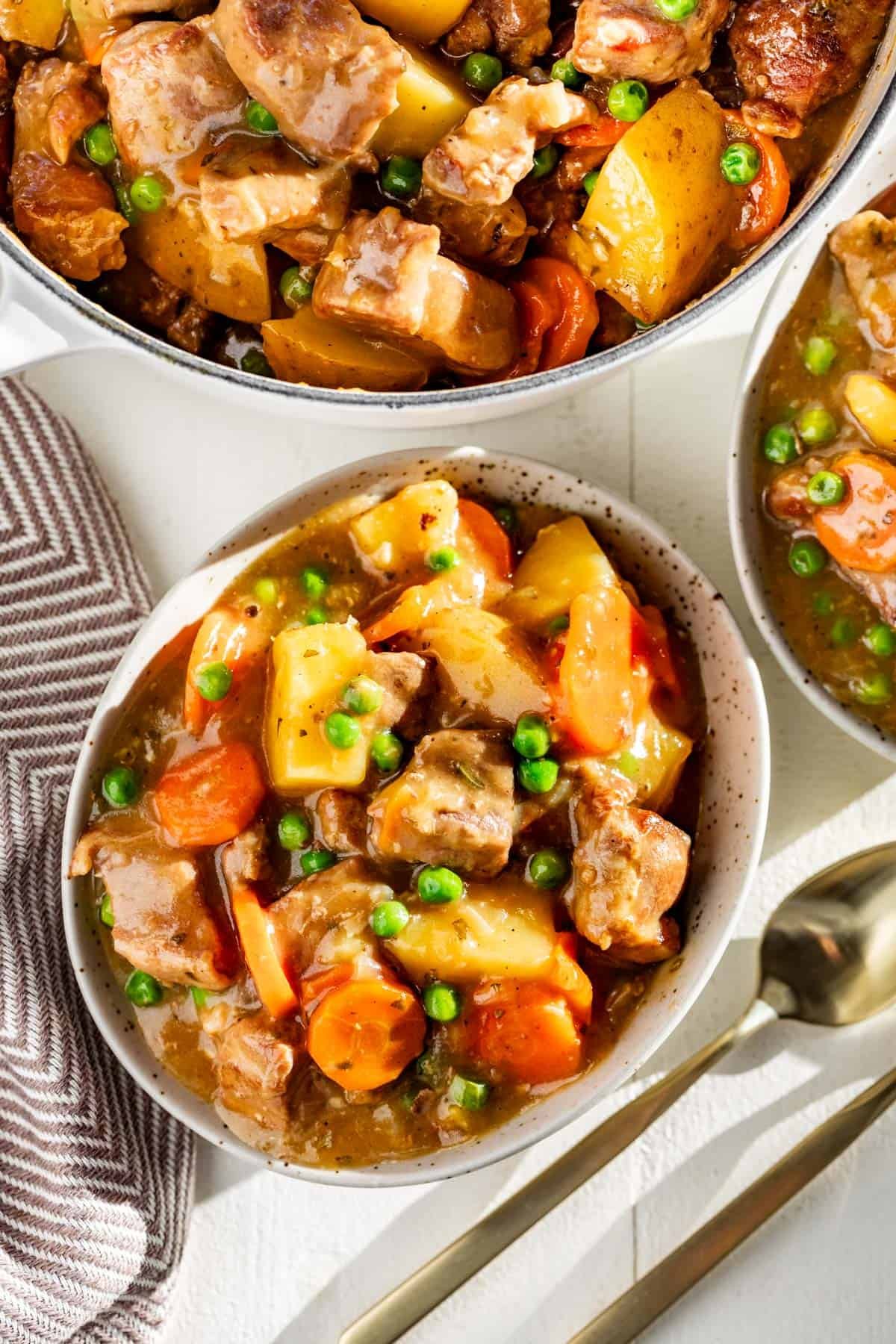
Tyler’s family has high standards for incredible stew, so I know you’ll love this pork version. In fact, there’s a funny family story of my father-in-law’s brother scarfing down a large container of beef stew his wife made when the border guards tried to make him throw it away when he was heading down to the States!
He told them he would not surrender his stew, and he pulled over to eat the whole thing! It’s even funnier to hear him tell about it, but just know that in a family where stew is taken that seriously… this stew has been a hit!
Ingredients & Substitutions
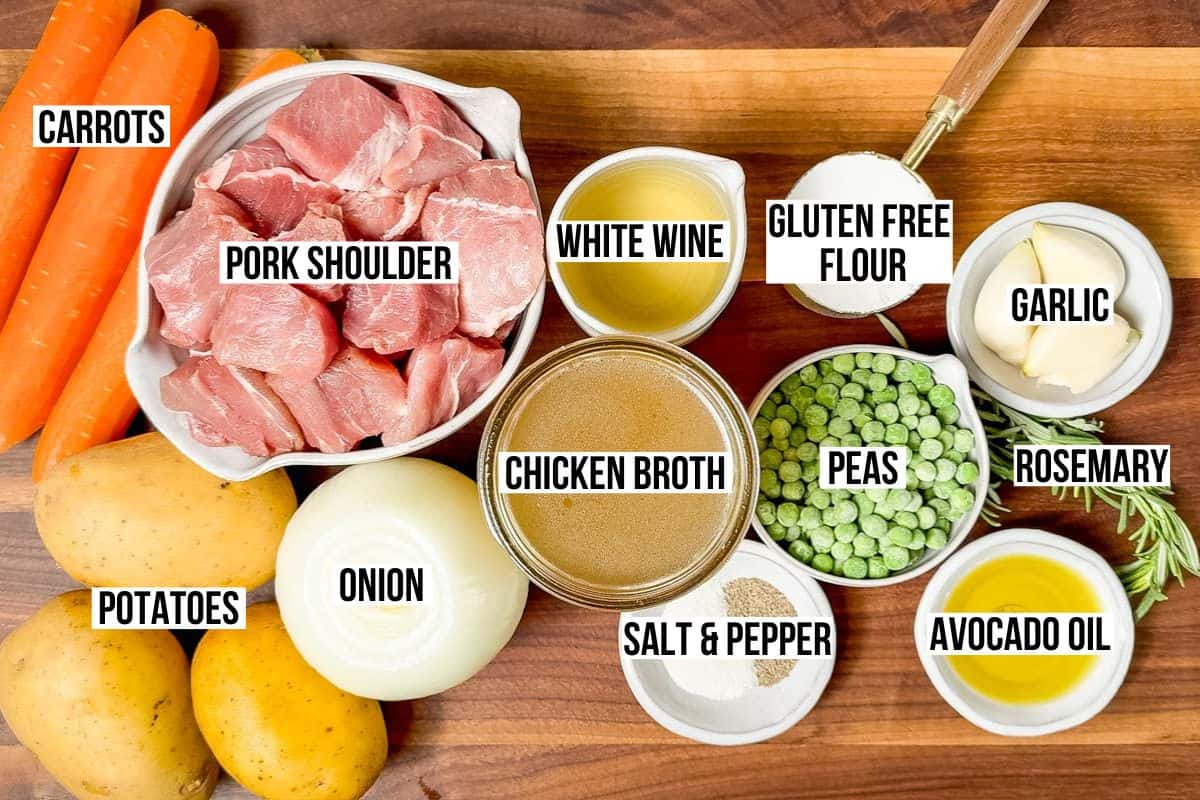
- Pork Stew Meat – I like to use cubed-up pork shoulder here, but pork butt will also work. Pork butt has more fat that needs to be trimmed away, so buy a little extra.
- Oil – I like to use avocado oil to sear the pork because it can tolerate higher temperatures without smoking, but you can use whatever oil you’d like; olive oil would also work.
- Onion and garlic – are the flavor base of any good stew, so fresh onion and garlic are a must in this recipe.
- Flour – is what turns all the juices into a velvety, soft, rich gravy to surround the pork and veggies. I use gluten-free 1:1 from Bob’s Red Mill, and it works perfectly. But you can also use all-purpose flour if desired.
- Fresh herbs – I like rosemary in pork stew because it’s a nice flavor pairing, but thyme also works. You’ll find dried herb options in the recipe notes as well.
- Liquid – I like to use a mixture of white wine (sauvignon blanc) and chicken broth or homemade chicken stock for the best depth of flavor, but you can use just boxed chicken broth or beef broth if desired.
- Vegetables—potatoes, carrots, and peas are what I know and love in a stew. I like to use either Yukon gold potatoes or red potatoes, but baby potatoes also work here.
How to make this recipe step by step
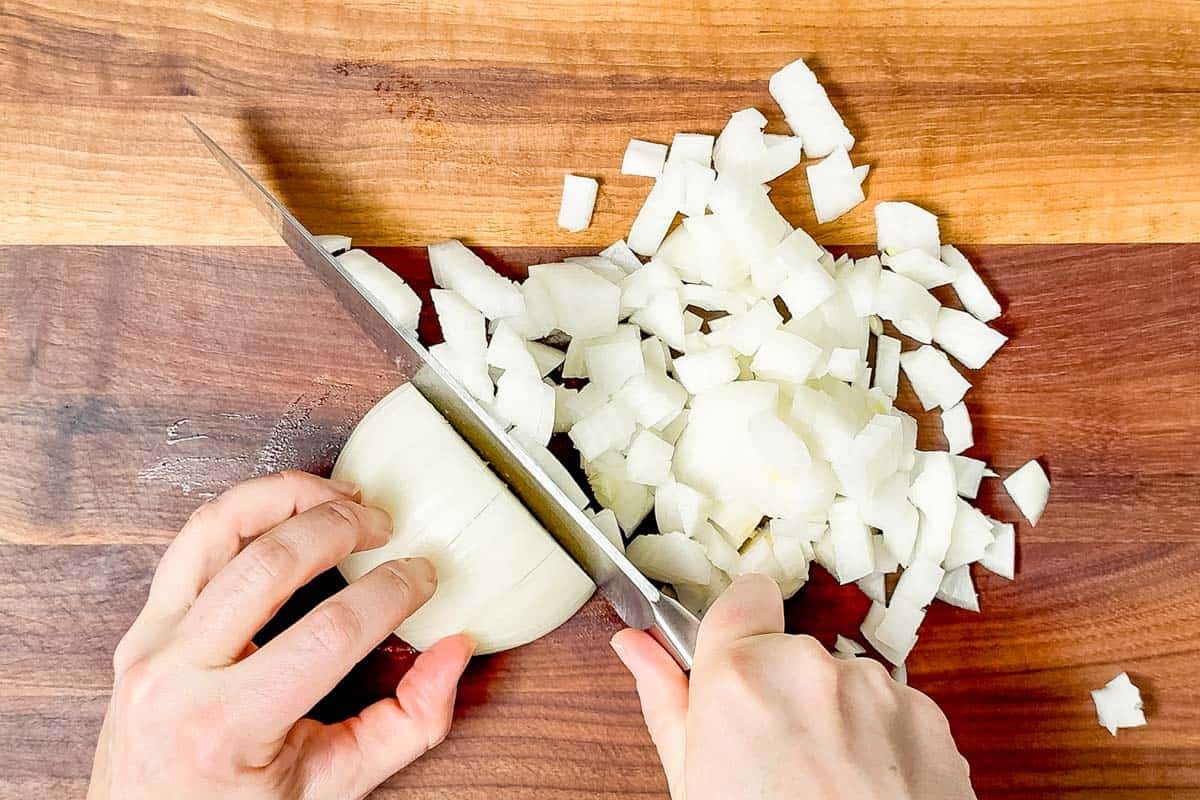
Step 1: Start by dicing the onion, mincing the garlic and rosemary. Set them aside and preheat a large Dutch oven over medium-high heat.
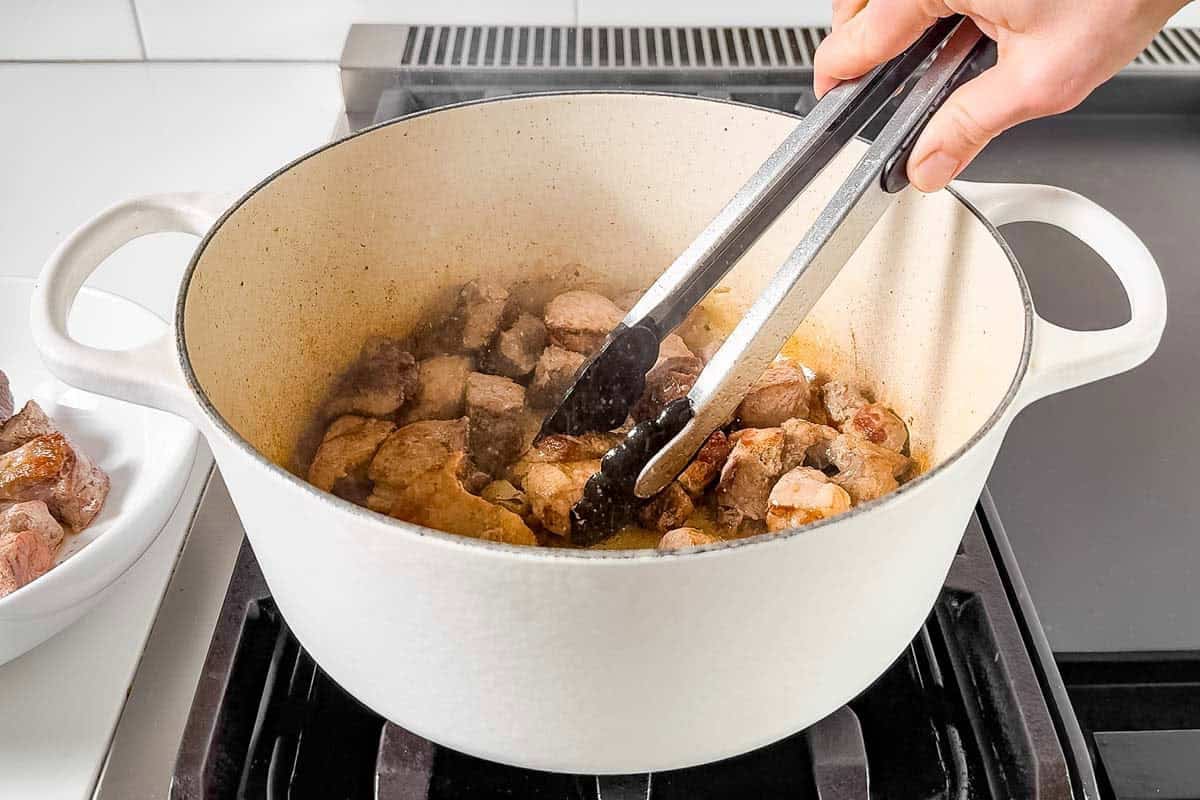
Step 2: When the pan is hot but not smoking, add the oil, then sear the cubed-up pork roast in 2-3 batches.
I use a 5.5-quart Dutch oven. Repeat the cooking process until all the pieces of meat are browned.
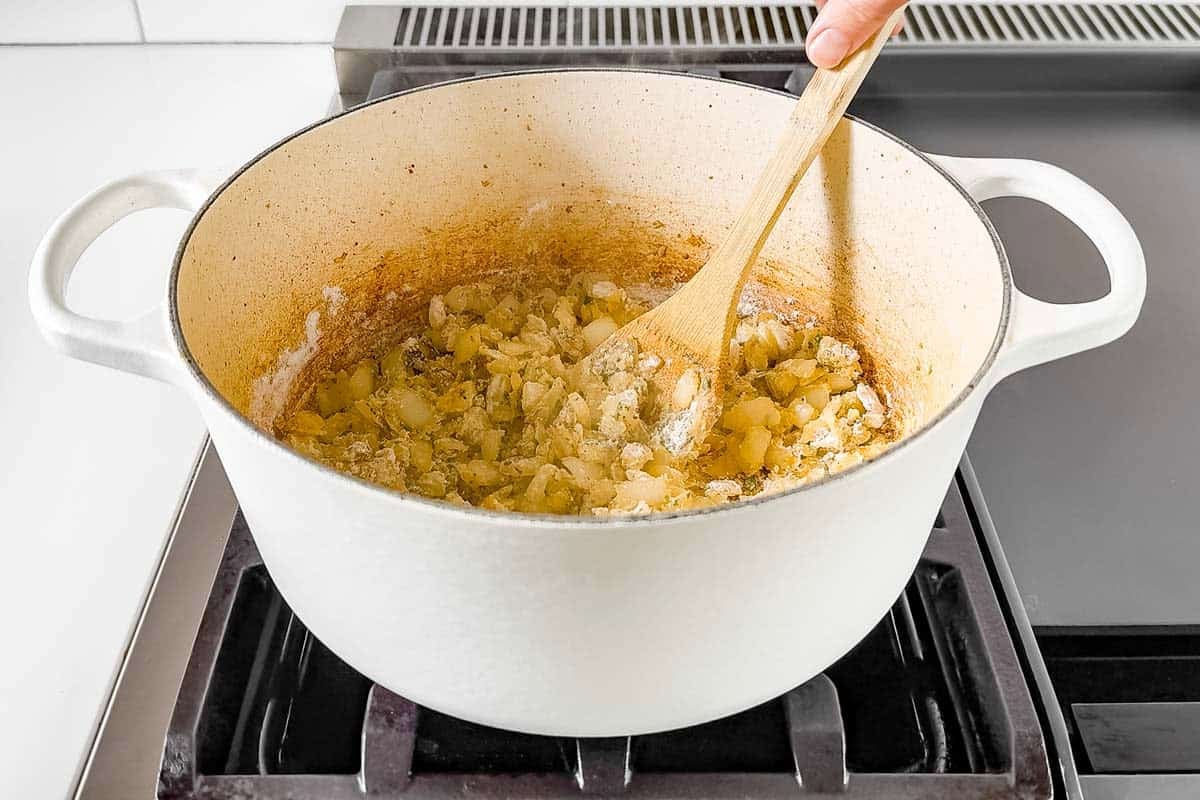
Step 3: When the batches of pork are done, sauté the chopped onion and garlic over medium heat in the remaining oil until golden brown and softened. Stir in the flour to completely combine it, along with the rosemary.
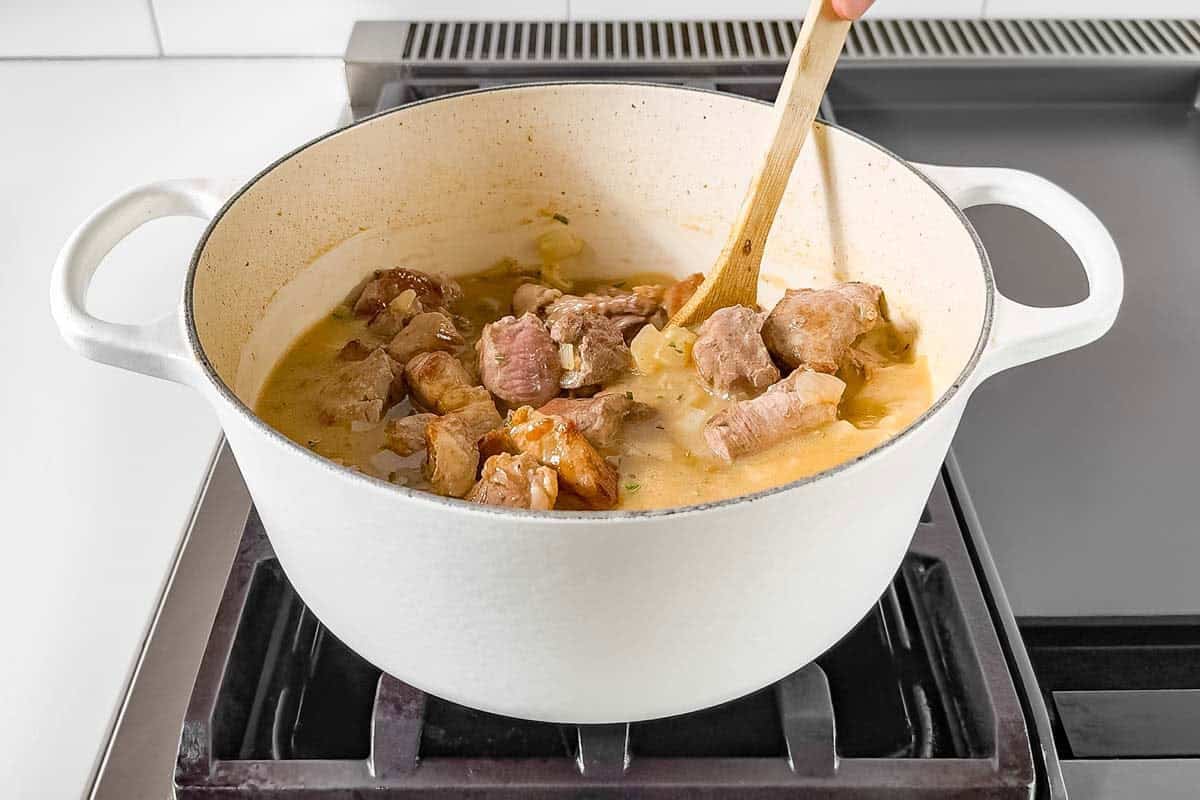
Step 4: Add the white wine to the pan and scrape up the brown bits from the bottom before adding the chicken broth and browned pork. Bring this mixture to a simmer.
Next, cover the Dutch oven and bake until the pork is beginning to get tender, about 1 hour.
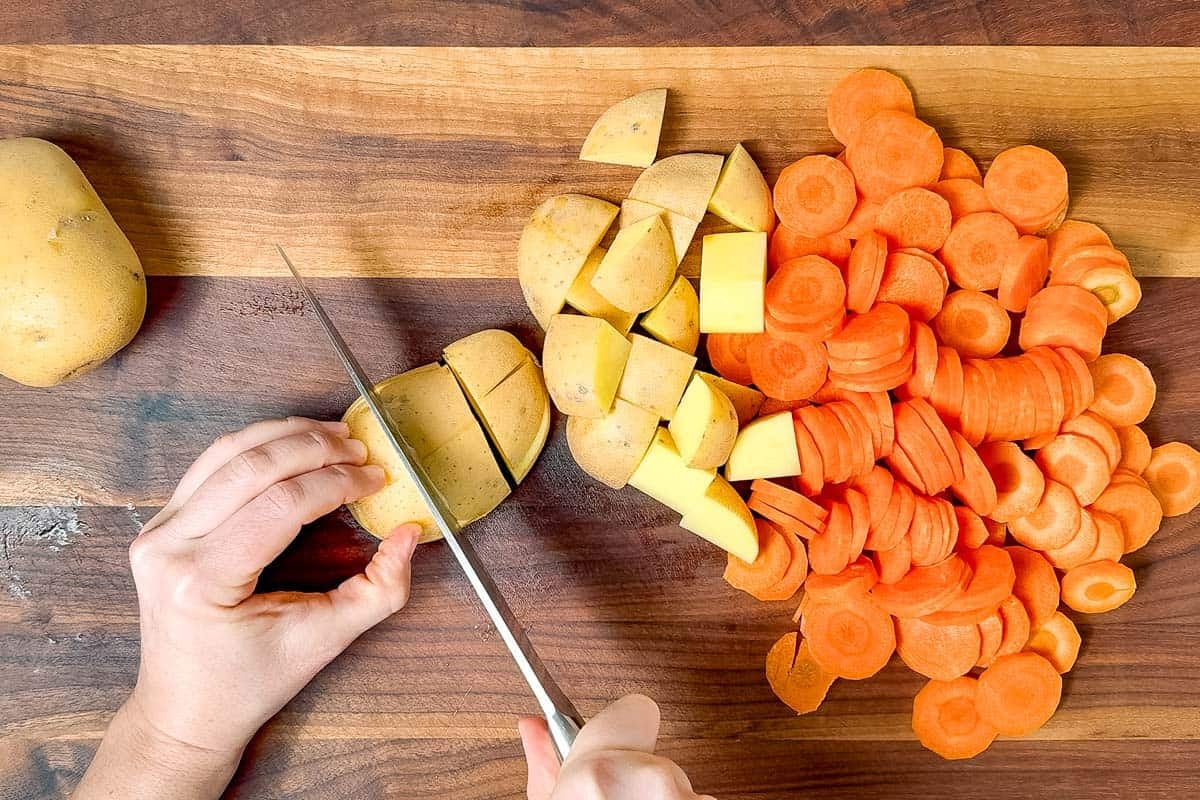
Step 5: Step 4: When the pork stew is mostly tender after the 1st hour of cooking, cut up the carrots and potatoes.
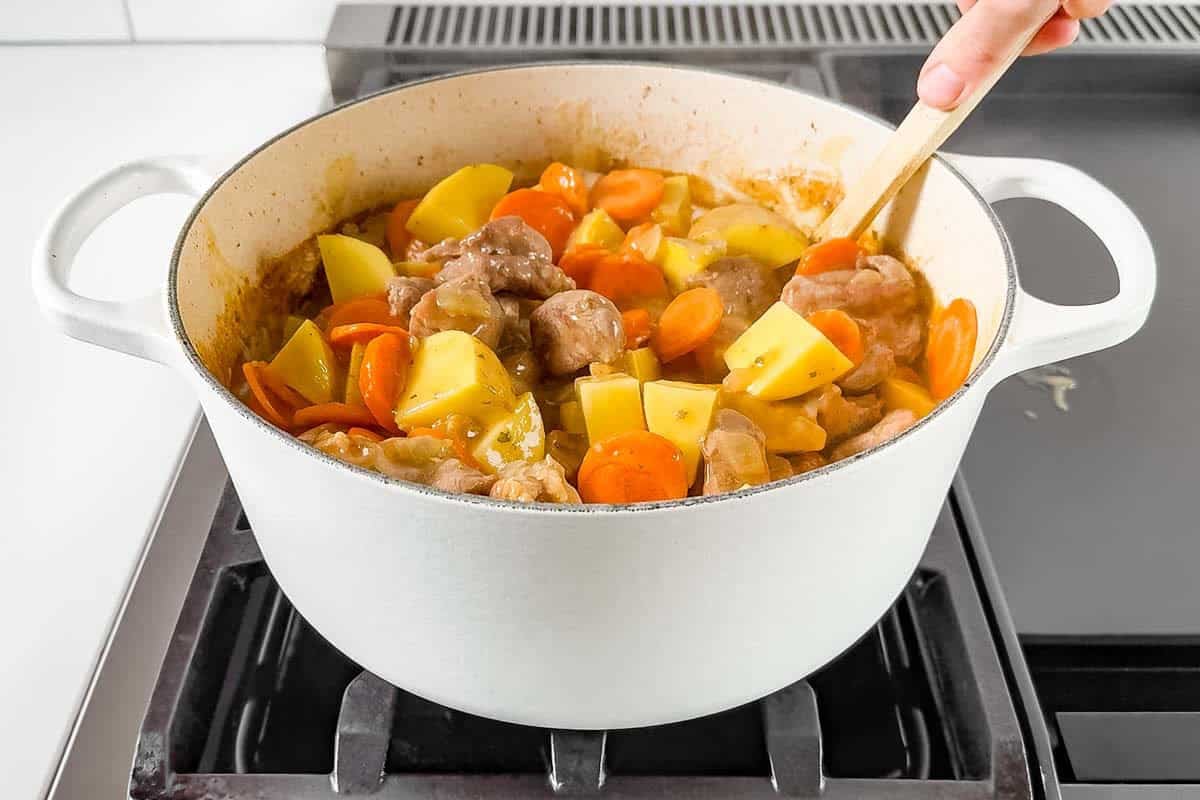
Step 6: Add the carrots and potatoes and mix to combine. Scrape the bottom of the pan again to prevent sticking.
Cover the Dutch oven and bake again for 1 hour to 1 hour 15 minutes or just until the pork is falling apart and fork tender.
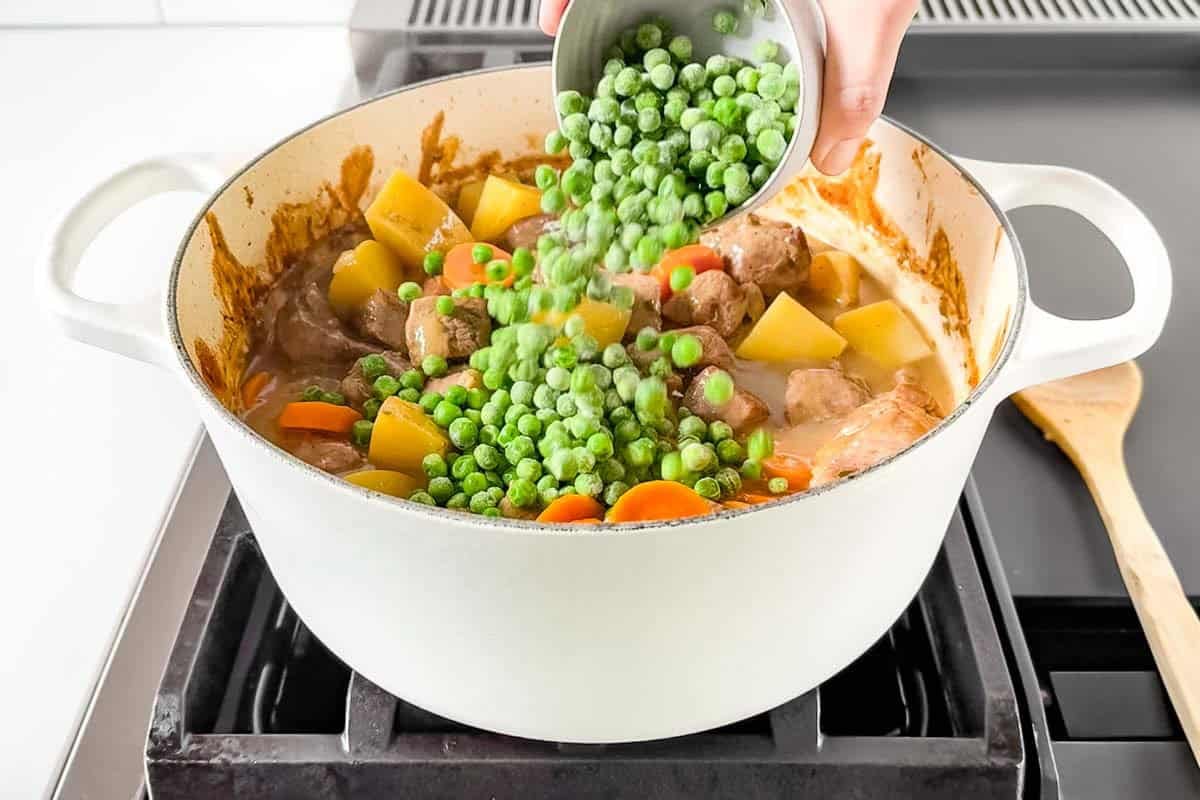
Step 7: When the meat is tender, add the peas and allow the residual heat of the pork stew to cook them while you season the stew to taste with sea salt and pepper.
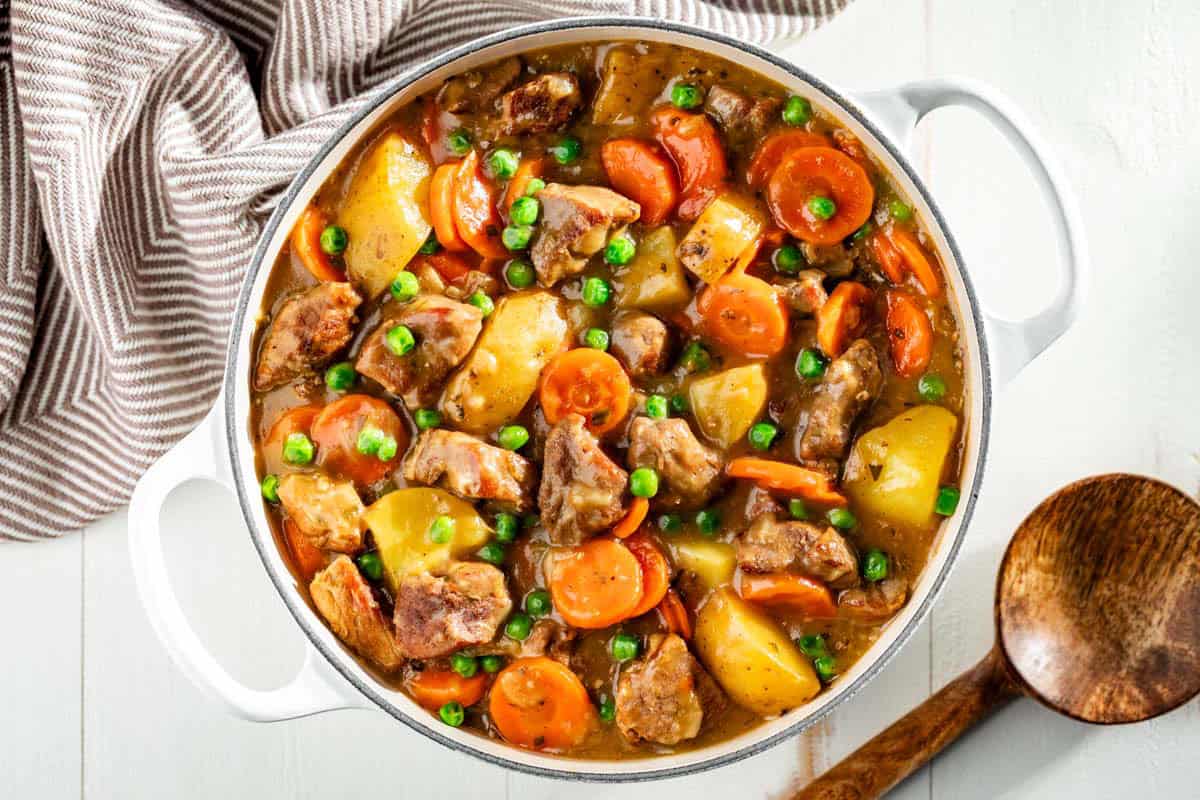
Ways to serve this
- This recipe is a one-pot meal, but you could add a lovely Easy Green Salad or Apple Spinach Salad.
- For another green veggie, try adding my Sautéed Green Beans.
- You can also serve this with crusty bread or your favorite biscuits, which is how I often remember stew being served when I was growing up.
- For dessert, try a classic like my Apple Crisp or Death by Chocolate.
FAQ’s
Pork shoulder is the best cut of pork for stew because it becomes meltingly tender and doesn’t dry out. Pork butt also works, but you need to trim away a lot more fat first.
Lean meat does not work well in stew because it becomes dry and stringy. You want a cut of pork or beef that has enough marbling to keep it moist for the long cooking time it needs to be tender.
Storing leftovers
- To store – place any leftovers into an airtight container and store them in the refrigerator for 4-5 days.
- Make ahead – this stew tastes even better the next day and reheats well so you can make it ahead.
- Reheating – place any leftovers into a saucepan and heat, stirring constantly over medium-high heat until heated through. Or heat on low, covered with a lid, stirring occasionally until heated through.
- To freeze – the stew freezes fairly well, but the vegetables do come out a bit mushy. Place in an airtight container and store in the freezer for up to 3 months. Defrost in the fridge overnight before reheating as directed above.
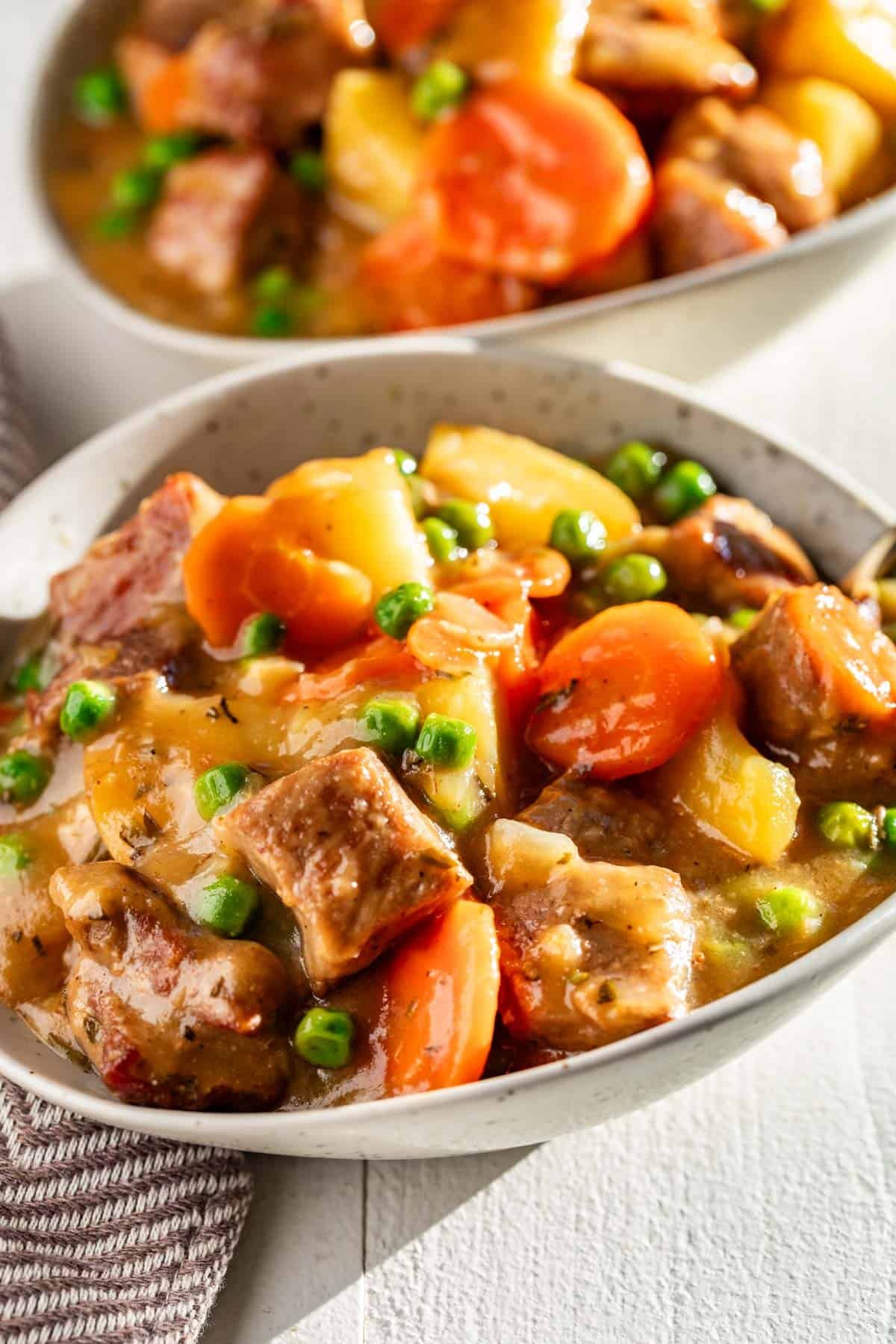
Tips & Tricks
- Pork shoulder really does make all the difference to the flavor of this stew. Be sure to trim it of excess fat so you don’t have any chewy bits in the finished pork stew.
- Also, don’t rush browning the cubed-up beef, the deep brown color is key and it’s what brings a depth of flavor to your finished stew.
- Be sure to season well with sea salt and pepper; a well-seasoned stew is extremely important to the flavor. If it tastes bland, chances are it’s still lacking in salt.
- Don’t be afraid to make this ahead because it tastes even better the next day.
- You can make this pork stew without the wine, but it does add a nice depth of flavor. Look for a dry white wine like Sauvingnon Blanc, not a sweet wine. You can also use the broth/vinegar option in the recipe notes.
Dietary Options & Substitutions
- Paleo or Whole30 – omit the gluten-free flour. Then, when the stew is done, thicken it with tapioca starch mixed with water until smooth. Add the starch mixture to the bubbling pork stew just until your desired texture is reached. For Whole30, omit the peas as well.
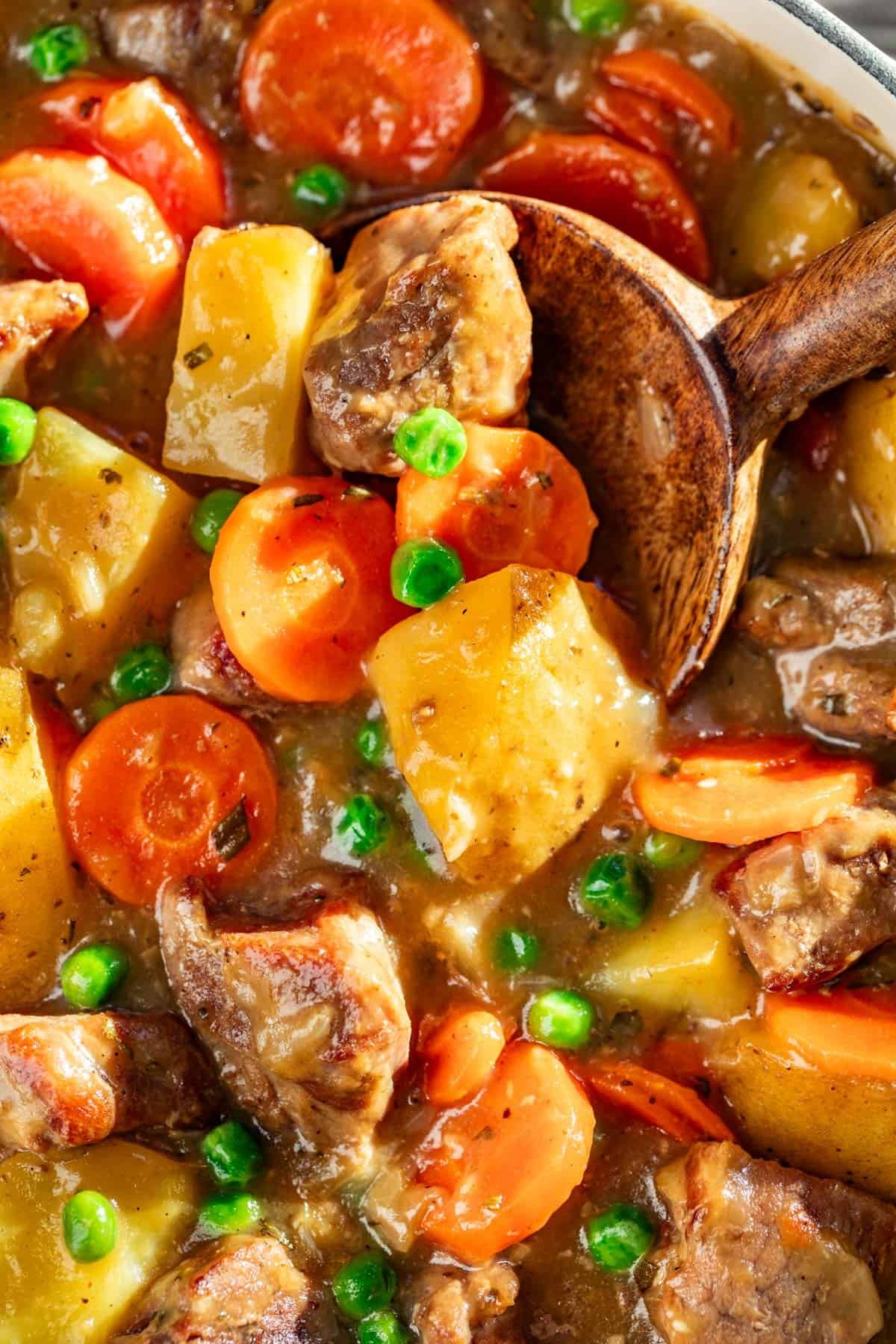
More Pork Recipe Inspiration
I really hope you enjoy this hearty Pork Stew recipe! If you do get a chance to make it, I’d love to hear from you in the comments. And if you’re a big stew fan, you’ll enjoy my Dutch Oven Beef Stew, too.
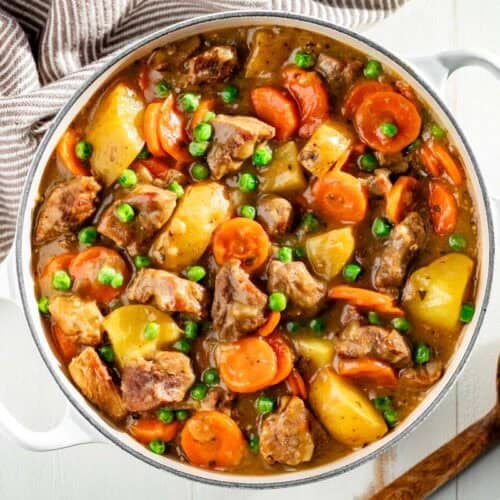
Pork Stew
INGREDIENTS
- 3 pounds Pork Shoulder Roast - 1.5" cubes with excess fat trimmed
- 1 tbsp avocado oil - more if needed
- 1 large onion - or white, cut into 1/2" dice
- 4 cloves garlic - minced
- 1/3 cup gluten-free flour - I use Bob's Red Mill 1:1, or all-purpose flour
- 1 tsp sea salt
- 1 tsp black pepper
- 1.5 tbsp chopped fresh rosemary - see notes
- 1 cup dry white wine - Sauvignon Blanc, see notes
- 3 cups chicken broth - low sodium
- 1 pound potatoes - cut into 1" pieces
- 1 pound carrots - (4) 1/4" slices
- 1 cup frozen peas
INSTRUCTIONS
- Start by preheating the oven to 300ºF. Cut the pork shoulder roast into 1.5" cubes and trim it of excess fat. Place a large 5.5-quart Dutch oven over medium-high heat. When the pan is hot, add the oil and sear the cubed pork roast in 2-3 batches until well-browned.
- Remove the browned cubed pork from the pan as it cooks. When all the pork is done, lower the heat to medium and add the diced onion and garlic to the pan.
- Cook the onion mixture, stirring occasionally until it is golden brown and tender, about 4-5 minutes. Add the flour, sea salt, and pepper and mix to combine.
- Next, add the rosemary, white wine, and chicken broth. Stir to combine and distribute the flour into the liquid and scrape up any browned bits on the bottom.
- Add the sautéed pork back to the pot. Bring the mixture to a simmer. Then, cover the Dutch oven and bake for 1 hour.
- Near the end of the first hour of cooking time, cube up the potatoes and slice the carrots. Then, remove the pork stew from the oven and mix in the carrots and potatoes.
- Cover the Dutch oven and bake again for 1 hour. Test to see if the pork is fork-tender. If not, bake for an additional 15 minutes and check again. Times could vary a bit depending on how accurate your oven temperature is.
- When the pork is fork-tender, remove the pork stew from the oven. Stir in the peas and allow the boiling heat of the stew to cook them.
- Season to taste with additional sea salt and pepper if desired, and serve.


This stew looks so tempting that I’m going to make it. It’s with my favourite meat, which is pork, and the vegetables are a classic stew variety. It will cook up a tempting treat in my Dutch Oven.
I really hope you enjoy it, and be sure to let me know if you try it out!